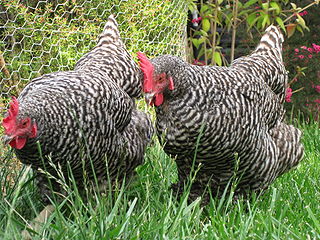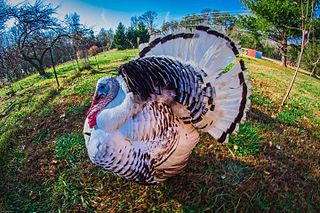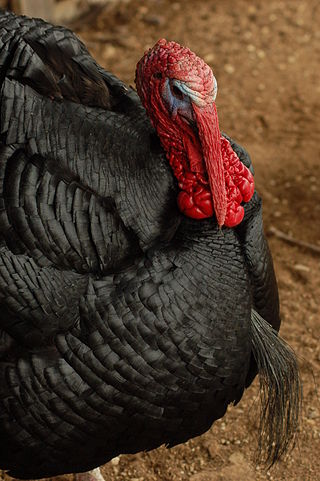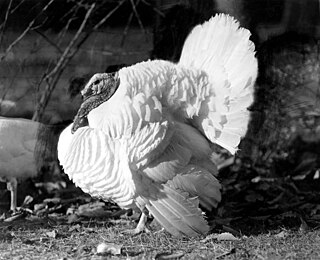
The American Game is an American breed of game fowl, chickens bred specifically for cockfighting. It has many color varieties, and may also be kept for ornament.

The Rhode Island Red is an American breed of domestic chicken. It is the state bird of Rhode Island. It was developed there and in Massachusetts in the late nineteenth century, by cross-breeding birds of Oriental origin such as the Malay with brown Leghorn birds from Italy. It was a dual-purpose breed, raised both for meat and for eggs; modern strains have been bred for their egg-laying abilities. The traditional non-industrial strains of the Rhode Island Red are listed as "watch" by The Livestock Conservancy. It is a separate breed to the Rhode Island White.

The Cochin is a breed of large domestic chicken. It derives from large feather-legged chickens brought from China to Europe and North America in the 1840s and 1850s. It is reared principally for exhibition. It was formerly known as Cochin-China.

The Plymouth Rock is an American breed of domestic chicken. It was first seen in Massachusetts in the nineteenth century and for much of the early twentieth century was the most widely kept chicken breed in the United States. It is a dual-purpose bird, raised both for its meat and for its brown eggs. It is resistant to cold, easy to manage, and a good sitter.

The Bourbon Red is an American breed of domestic turkey. It is named for its reddish-brown plumage and for its area of origin, Bourbon County, Kentucky, where it was developed in the last years of the nineteenth century. It was accepted into the Standard of Perfection of the American Poultry Association in 1909, and in the early twentieth century was an important commercial meat breed until the Broad Breasted White began to dominate industrial production. The Bourbon Red is considered a heritage turkey; it is an endangered breed, classified as 'watch' by the Livestock Conservancy. It was formerly known as the Bourbon Butternut or as the Kentucky Red.

The Livestock Conservancy, formerly known as the American Livestock Breeds Conservancy (ALBC) and prior to that, the American Minor Breeds Conservancy, is a nonprofit organization focused on preserving and promoting rare breeds, also known as "heritage breeds" of livestock. Founded in 1977, through the efforts of livestock breed enthusiasts concerned about the disappearance of many of the US's heritage livestock breeds, The Livestock Conservancy was the pioneer livestock preservation organization in the United States, and remains a leading organization in that field. It has initiated programs that have saved multiple breeds from extinction, and works closely with similar organizations in other countries, including Rare Breeds Canada. With 3,000 members, a staff of eleven and a 19-member board of directors, the organization has an operating budget of over a million dollars.

The Magpie is a British breed of domestic duck. It has distinctive black and white markings reminiscent of the European magpie, and is a good layer of large eggs.

The Buckeye is an American breed of chicken. It was created in Ohio in the late nineteenth century by Nettie Metcalf. The color of its plumage was intended to resemble the color of the seeds of Aesculus glabra, the Ohio Buckeye plant for which the state is called the 'Buckeye State'.
The Nankin Bantam or Nankin is a British bantam breed of chicken. It is a true bantam, a naturally small breed with no large counterpart from which it was miniaturised. It is of South-east Asian origin, and is among the oldest bantam breeds. It is a yellowish buff colour, and the name is thought to derive from the colour of nankeen cotton from China.

The Rhode Island White is a breed of chicken originating in the U.S. state of Rhode Island. Despite their very similar names and shared place of origin, the Rhode Island White is a distinct breed from the Rhode Island Red. However, Rhode Island Reds and Whites can be bred together to create Red Sex-Link hybrid chickens, such as the ISA Brown. In Australia, the Rhode Island White is regarded as a color variety of the Rhode Island breed according to the Australian Poultry Standards.

The Java is a breed of chicken originating in the United States. Despite the breed's name, a reference to the island of Java, it was developed in the U.S. from chickens of unknown Asian extraction. It is one of the oldest American chickens, forming the basis for many other breeds, but is critically endangered today. Javas are large birds with a sturdy appearance. They are hardy, and are well-suited for both meat and egg production, especially by small-scale farms, homesteads, and backyard keepers.

The Narragansett turkey is a breed of Meleagris gallopavo which descends from a cross between the eastern wild turkey and the domestic turkey. According to the American Livestock Breeds Conservancy, the Narragansett turkey is a "historic variety, unique to North America" and is named for Narragansett Bay.

The Royal Palm is a breed of domestic turkey. It is not primarily selected for meat production, and is usually kept as an ornamental bird with a unique appearance, largely white with bands of metallic black.

The Bronze is a breed of domestic turkey. The name refers to its plumage, which bears an iridescent bronze-like sheen. The Bronze had been the most popular turkey throughout most of American history, but waned in popularity beginning in the mid-20th century. Later in its history, the breed was divided into two distinct types: the Broad Breasted Bronze and the Standard Bronze. A great deal of confusion exists about the difference between Standard and Broad Breasted Bronzes, or whether there is any difference at all. Collectively, the Standard and Broad Breasted varieties are simply called the Bronze turkey.

The Norfolk Black, also known as the Black Spanish or Black Turkey, is a British breed of domestic turkey. It is thought to derive from birds taken to Britain from Spain, where they had arrived with Spanish explorers returning from the New World.
The Slate, or Blue Slate, is a breed of domestic turkey known for the slate gray color of its plumage. Lighter birds are sometimes called Lavender turkeys. Turkeys of the Slate breed may actually be any number of shades between pure black and white, but only ash-gray birds are eligible for showing under the directive of the American Poultry Association’s ‘’Standard of Perfection’’, into which they admitted as a variety in 1874. Slate turkeys are listed as critically endangered by the American Livestock Breeds Conservancy, and meet the definition of a heritage turkey breed.

The Beltsville Small White is a modern American breed of domestic turkey. It was developed from 1934 at the Beltsville Agricultural Research Center of the United States Department of Agriculture in Beltsville, Maryland, and was named for that town and for its physical characteristics — small size and white plumage. It enjoyed a brief period of commercial success in the mid-twentieth century, but numbers then declined sharply; in the twenty-first century it is an endangered breed, and may be considered a heritage turkey breed.
The Buff or Jersey Buff is a breed of domestic turkey named for its buff-colored plumage.

The Midget White is a breed of domestic turkey named for its white plumage and small stature. The breed is the smallest standard variety of turkey, and with toms at roughly 13 lbs and hens 8-10 lbs, it weighs only slightly more than the largest chickens.
Heritage Foods USA is an American heritage meat distribution company with offices in Brooklyn, New York. It was formed in 2001 as the sales and marketing arm of Slow Food USA — a non-profit organization founded by Patrick Martins, dedicated to celebrating regional cuisines and ingredients. The Heritage Turkey Project, which helped double the population of heritage turkeys in the United States and upgraded the Bourbon Red turkey from “rare” to “watch” status on conservation lists, was Heritage Foods USA’s first project aimed at heritage breed preservation. In 2004, it became an independent company selling heritage breed meat to top tiered restaurants and consumers.


















